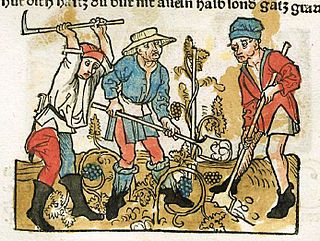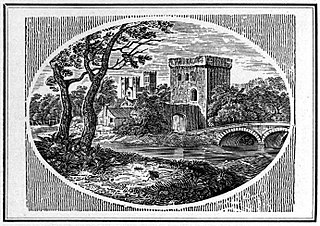
Aesop's Fables, or the Aesopica, is a collection of fables credited to Aesop, a slave and storyteller who lived in ancient Greece between 620 and 564 BCE. Of diverse origins, the stories associated with his name have descended to modern times through a number of sources and continue to be reinterpreted in different verbal registers and in popular as well as artistic media.

The Boy Who Cried Wolf is one of Aesop's Fables, numbered 210 in the Perry Index. From it is derived the English idiom "to cry wolf", defined as "to give a false alarm" in eBrewer's Dictionary of Phrase and Fable and glossed by the Oxford English Dictionary as meaning to make false claims, with the result that subsequent true claims are disbelieved.
The lion's share is an idiomatic expression which now refers to the major share of something. The phrase derives from the plot of a number of fables ascribed to Aesop and is used here as their generic title. There are two main types of story, which exist in several different versions. Other fables exist in the East that feature division of prey in such a way that the divider gains the greater part - or even the whole. In English the phrase used in the sense of nearly all only appeared at the end of the 18th century; the French equivalent, le partage du lion, is recorded from the start of that century, following La Fontaine's version of the fable.

"The Goose that Laid the Golden Eggs" is one of Aesop's Fables, numbered 87 in the Perry Index, a story that also has a number of Eastern analogues. Many other stories contain geese that lay golden eggs, though certain versions change them for hens or other birds that lay golden eggs. The tale has given rise to the idiom 'killing the goose that lays the golden eggs', which refers to the short-sighted destruction of a valuable resource, or to an unprofitable action motivated by greed.
The Ass and the Pig is one of Aesop's Fables that was never adopted in the West but has Eastern variants that remain popular. Their general teaching is that the easy life and seeming good fortune of others conceal a threat to their welfare.
The Hawk and the Nightingale is one of the earliest fables recorded in Greek and there have been many variations on the story since Classical times. The original version is numbered 4 in the Perry Index and the later Aesop version, sometimes going under the title "The Hawk, the Nightingale and the Birdcatcher", is numbered 567. The stories began as a reflection on the arbitrary use of power and eventually shifted to being a lesson in the wise use of resources.

The Fox and the Lion is one of Aesop's Fables and represents a comedy of manners. It is number 10 in the Perry Index.

Speaking of The Snake and the Crab in Ancient Greece was the equivalent of the modern idiom, 'Pot calling the kettle black'. A fable attributed to Aesop was eventually created about the two creatures and later still yet another fable concerning a crab and its offspring was developed to make the same point.

The Fox and the Weasel is a title used to cover a complex of fables in which a number of other animals figure in a story with the same basic situation involving the unfortunate effects of greed. Of Greek origin, it is counted as one of Aesop's Fables and is numbered 24 in the Perry Index.
The Fox and the Woodman is a cautionary story against hypocrisy included among Aesop's Fables and is numbered 22 in the Perry Index. Although the same basic plot recurs, different versions have included a variety of participants.
The Fowler and the Snake is a story of Greek origin that demonstrates the fate of predators. It was counted as one of Aesop's Fables and is numbered 115 in the Perry Index.

The Dove and the Ant is a story about the reward of compassionate behaviour. Included among Aesop's Fables, it is numbered 235 in the Perry Index.

The Snake and the Farmer is a fable attributed to Aesop, of which there are ancient variants and several more from both Europe and India dating from Mediaeval times. The story is classed as Aarne-Thompson-Uther type 285D, and its theme is that a broken friendship cannot be mended. While this fable does admit the possibility of a mutually beneficial relationship between man and snake, the similarly titled The Farmer and the Viper denies it.

The Ape and the Fox is a fable credited to Aesop and is numbered 81 in the Perry Index. However, the story goes back before Aesop’s time and an alternative variant may even be of Asian origin.

The Farmer and his Sons is a story of Greek origin that is included among Aesop's Fables and is listed as 42 in the Perry Index. It illustrates both the value of hard work and the need to temper parental advice with practicality.

The Eagle and the Fox is a fable of friendship betrayed and revenged. Counted as one of Aesop’s Fables, it is numbered 1 in the Perry Index. The central situation concerns an eagle that seizes a fox’s cubs and bears them off to feed its young. There are then alternative endings to the story, in one of which the fox exacts restitution while in the other it gains retribution for its injury.

The Kite and the Doves is a political fable ascribed to Aesop that is numbered 486 in the Perry Index. During the Middle Ages the fable was modified by the introduction of a hawk as an additional character, followed by a change in the moral drawn from it.

The Fly and the Ant is one of Aesop’s Fables that appears in the form of a debate between the two insects. It is numbered 521 in the Perry Index.
The fable of The Fox, the Flies and the Hedgehog is ascribed to Aesop’s Fables. From its beginning it was applied satirically to political leaders and is numbered 427 in the Perry Index.
The Frog and the Fox is one of Aesop's Fables and is numbered 289 in the Perry Index. It takes the form of a humorous anecdote told against quack doctors.













